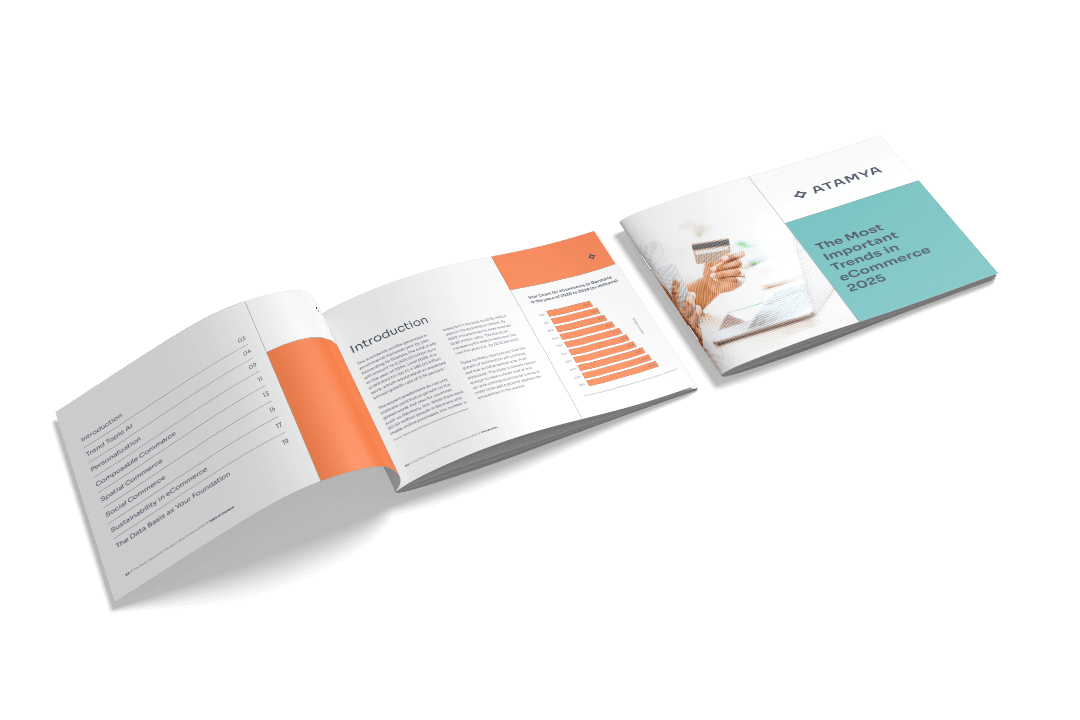The Most Important eCommerce Trends 2025
Do you want to stay one step ahead of the competition? Then discover further ecommerce trends for 2025 in our whitepaper now.


Tiffany Wiener
20 / 09 / 24·9 Min read
eCommerce
Companies in the field of ecommerce are subject to ever-increasing pressure to not only keep up with but also stay one step ahead of the competition – while also replying to changes on the market as quickly as possible. Classic business models often times hit a limit when it comes to meeting the market’s dynamic requirements and providing customers individual, personalized purchasing experiences across the entire customer journey. And it is here where the concept of Composable Commerce is coming more and more into focus as the promising solution.
Lars Bankert, Senior Manager and Head of Business Unit PIM & DAM for Vanilla Reply, a company specializing in web apps and ecommerce, comes together with Gerd Laski, Director Partner & Alliances for ATAMYA, to grant you valuable insights into this concept in the form of an interview. They share useful knowhow and demonstrate why Composable Commerce is indispensable for companies.
Lars Bankert: Composable Commerce is the method with which companies can build their ecommerce platform using various software components specifically designed for this very purpose. Such modular software components enable companies to quickly adapt to market changes, while enjoying the option to adjust and recompose their systems in a flexible manner. In today’s digital landscape, where the customers’ requirements change continuously, Composable Commerce offers the much needed agility and adaptability needed in order to optimize product experience and staying competitive.
Gerd Laski: As the provider of the PIM solution ATAMYA Product Cloud, which is based on the principles of the MACH architecture, we support the Composable Commerce method. Overall, the prototypical ecommerce infrastructure encompasses not only the PIM system but also other important software components such as online shops, billing processors, or marketplaces. Companies can choose between and put together technologies that best fit their needs to accomplish their goals. This so-called best-of-breed approach, also commonly referred to as freedom of choice, is decisive for making ecommerce companies scalable, maintainable, and continuously successful without any shutdowns, turnarounds, or outages. The future requirements of an ecommerce ecosystem often times remain indeterminate given the fast-paced market trends – with this method, however, you can implement and operate them in an uncomplicated manner.
Gerd Laski: Headless refers to the independency between frontend and backend. This means that a system can operate without a static and fixed frontend, allowing for the division of labor between frontend and backend software components. On the basis of this, various frontend technologies can be connected to the ecommerce system using APIs – without changes in the frontend affecting the backend. This approach offers companies maximum flexibility when it comes to the design of their ecommerce platform.
Composable Commerce builds upon the concept of Headless Commerce, but takes it even one step further with the implementation of microservices. Microservices are independent, self-sufficient modules that are developed individually and are highly flexible. What is hereby made possible is an all-encompassing modularization and adaptivity for the entire ecommerce ecosystem, not just the frontend.
Lars Bankert: APIs and microservices are the central building blocks of Composable Commerce. While APIs guarantee the smooth communication between the various modular software components, the previously mentioned microservices subdivide the overall functionality into smaller units that can be managed independently. This structure facilitates the integration of new technologies and functions. The API-First Approach assures that each and every component is easily accessible and can communicate with other relevant software components in the system environment without any gaps. Only with the use of these state-of-the-art technologies can the flexible composition of a company’s system landscape be fully realized.
Lars Bankert: Composable Commerce offers countless benefits, including high flexibility and adaptivity thanks to the combination of best-of-breed solutions. Equipped with this modular structure, new technologies and functions can be integrated more quickly and existing software components can be replaced on demand. The shortened time to market enhances customer experience and boosts both, customer satisfaction and retention.
Modern technologies such as APIs and microservices secure future sustainability and facilitate continuous innovations. On top of all this, Composable Commerce improves the operative efficiency and enables fast reaction times to market shifts in the short-lived digital environment.
Lars Bankert: One of the greatest challenges is the integration of the various software components, in particular when they are sourced by different developers. This requires a well-grounded understanding of the API approach and robust middleware as the integration layer. Additionally, companies must make sure that their team is equipped with the necessary knowledge and skills to manage and optimize these complex systems – or they must bring service providers with suitable experts on board. A reliable consulting on this topic will coach companies about precisely these points and will work together with them to define solution strategies.
Gerd Laski: A PIM system is a central building block for the backbone of any “Composable eCommerce” architecture. Depending on the exact architectural approach, it receives product data from the ERP system and functions as the centralizing “single source of truth.” This means that all product data is here managed and maintained centrally.
Depending on the industry, product data such as texts, images, videos, and technical drawings from suppliers can be imported into the PIM system and, consequently, edited or enriched depending on given requirements. Furthermore, modern PIM systems offer functions like the automatic translation into various languages, the creation of target-group-specific product texts, as well as the contextualization of content. The PIM system supports even the internal maintenance of product data, including the distribution of information to the helpdesk. New requirements such as the Supply Chain Law and the Digital Product Pass can also be handled with a PIM in order to guarantee that all legal requirements are fulfilled.
Even a company’s partners and customers rely on encompassing product information to support the business effectively. This is why it is crucial that all this information is always available in all relevant formats. This includes print outlets such as datasheets and print catalogs, electronic catalogs such as BMEcat and ETIM, as well as the distribution of data across diverse sales channels, like the corporate online shop or marketplaces. This versatility is indispensable for data provision so that all the various requirements can be met. The right data must be provided in the right format at the right time and at the right spot – while involving minimal manual steps and delivering everything at highest speed. To be composable means in this context: regardless of what you need – the digital target system receives exactly all the information it needs to support the business in the best possible manner. Good PIM systems can integrate a Composable Commerce architecture effortlessly by utilizing APIs, hereby making the management and maintenance of product information much easier.
Lars Bankert: When it comes to the implementation of Composable Commerce, companies ought first to develop a clear ecommerce strategy which defines their business objectives and requirements. It is important to start with small, modular steps and adding further software components step by step. To this end, companies should rely on the best-of-breed approach and pay great care to the selection of the right partners and technologies. The software trainings of employees and the setup of robust API management frameworks, too, are crucial success indicators. Naturally, this method allows companies to successfully achieve business objectives as early as in the short term thanks to manageable, low-risk steps.
Lars Bankert: The future of Composable Commerce is promising. With ever-advancing digital transformation and growing demand for both flexibility and agility, more and more companies will opt for this method. The continuous development of technologies such as APIs, microservices, and cloud-native architectures will continue to make the implementation and administration of Composable Commerce much easier. In the long-term, companies will be well-capable of individualizing their e-commerce systems even more while also reacting even faster to market changes. The benefit of this method lies in the fact that, despite its high degree of individualization, you can always rely on battle-tested standard modules such as ecommerce, PIM, or personalization for every single phase of the customer journey.
Gerd Laski: Composable Commerce is already a well-established architecture in online retail today. Monolith systems will disappear more and more from the market. Even the classic suites develop into open systems. The trends clearly indicates that cloud-native microservice products gain in significance compared to on-premise solutions.
Our interview with Lars Bankert and Gerd Laski demonstrates that Composable Commerce bares significant influence on the future of ecommerce as a whole. For companies, this method provides the flexibility they need to quickly adjust their ecommerce platforms to ever-evolving market conditions. Through the use of modern software architectures powered by APIs and microservices, Composable Commerce constitutes smooth communication between the various systems involved, paired with an intuitive integration of new technologies.
The seamless integration of MACH PIM systems in Composable Commerce enables the distribution of product data across a diverse range of sales channels such as online shops, marketplaces, and even print catalogs in a flexible and efficient manner. This improves the overall operational effectiveness, shortens the time to market, and, last but not least, makes for a high-quality customer experience.
The Most Important eCommerce Trends 2025
Do you want to stay one step ahead of the competition? Then discover further ecommerce trends for 2025 in our whitepaper now.

These articles may also interest you